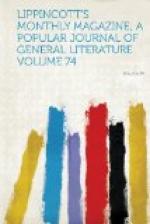On our way to this feast of solids we must step for a moment into St. Paul’s and listen to the great commemorative concert of sixty-five hundred voices that swept all cavilers, foreign and domestic, off their feet, brought tears to the most sternly critical eye, and caused the composer, Cramer, to exclaim, as he looked up into the great dome, filled with the volume of harmony, “Cosa stupenda! stupenda! La gloria d’Inghilterra!”
A transition, indeed, from this to coal and iron—from a concord of sweet sounds to the rumble into hold, car and cart of thirty-five millions of tons of coal and two and a half millions of iron, the yearly product at that time of England! She has since doubled that of iron, and nearly trebled her extract of coal, whatever her progress in the harvest of good music and good pictures. Forced by economical necessity and assisted by chemistry, she makes her fuel, too, go a great deal farther than it did in 1851, when the estimate was that eighty-one per cent. of that consumed in iron-smelting was lost, and when the “duty” of a bushel of coal burnt in a steam-engine was less than half what it now is. The United States have the benefit of these improvements, at the same time that their yield of coal has swelled from four millions of tons at that time to more than fifty now, and of iron in a large though not equal ratio. The Lake Superior region, which rested its claims on a sample of its then annual product of one hundred tons of copper, now exports seven hundred thousand tons of iron ore.
Steel, now replacing iron in some of its heaviest uses, appeared as almost an article of luxury in the shape of knives, scissors and the like. The success of the Hindus in its production was quite envied and admired, though they had probably advanced little since Porus deemed thirty pounds a present fit for Alexander; their rude appliances beating Sheffield an hour and a half in the four hours demanded by the most adroit forgers of the city of whittles for its elimination




